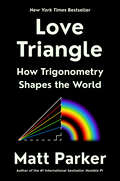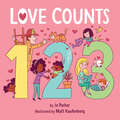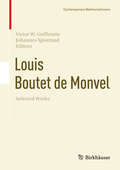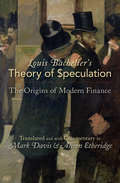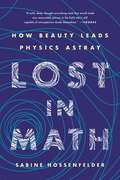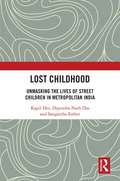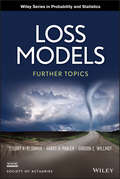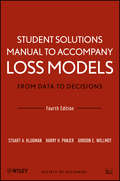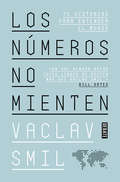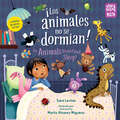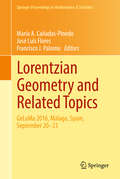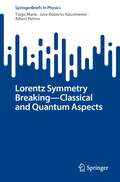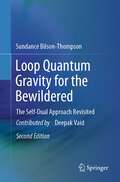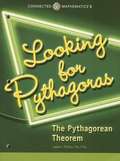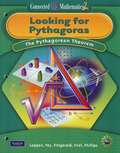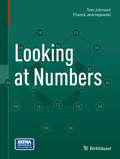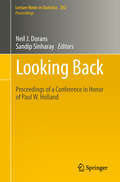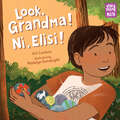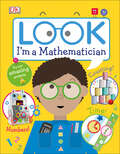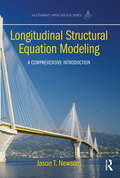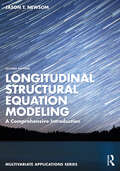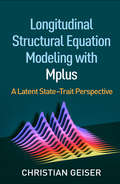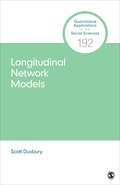- Table View
- List View
Love Triangle: How Trigonometry Shapes the World
by Matt ParkerAN INSTANT NEW YORK TIMES BESTSELLER!An ode to triangles, the shape that makes our lives possible Trigonometry is perhaps the most essential concept humans have ever devised. The simple yet versatile triangle allows us to record music, map the world, launch rockets into space, and be slightly less bad at pool. Triangles underpin our day-to-day lives and civilization as we know it. In Love Triangle, Matt Parker argues we should all show a lot more love for triangles, along with all the useful trigonometry and geometry they enable. To prove his point, he uses triangles to create his own digital avatar, survive a harrowing motorcycle ride, cut a sandwich, fall in love, measure tall buildings in a few awkward bounds, and make some unusual art. Along the way, he tells extraordinary and entertaining stories of the mathematicians, engineers, and philosophers—starting with Pythagoras—who dared to take triangles seriously. This is the guide you should have had in high school—a lively and definitive answer to &“Why do I need to learn about trigonometry?&” Parker reveals triangles as the hidden pattern beneath the surface of the contemporary world. Like love, triangles actually are all around. And in the air. And they&’re all you need.
Love Counts
by Jo ParkerCount down from 10 and discover the many ways children can spread love in the world!Whether it's sharing cookies with neighbors, sending a letter to a loved one, or giving thanks to the people who keep the world going 'round, this is the perfect book to read aloud with children to teach them that love counts.With playful rhymes and thoughtful illustrations, young readers will learn 10 simple ways to share love with family, neighbors, animals, teachers...and even themselves.
Louis Boutet de Monvel, Selected Works
by Victor W. Guillemin Johannes SjöstrandThis book features a selection of articles by Louis Boutet de Monvel and presents his contributions to the theory of partial differential equations and analysis. The works selected here reveal his central role in the development of his field, including three cornerstones: firstly, analytic pseudodifferential operators, which have become a fundamental aspect of analytic microlocal analysis, and secondly the Boutet de Monvel calculus for boundary problems for elliptic partial differential operators, which is still an important tool also in index theory. Thirdly, Boutet de Monvel was one of the first people to recognize the importance of the existence of generalized functions, whose singularities are concentrated on a single ray in phase space, which led him to make essential contributions to hypoelliptic operators and to a very successful and influential calculus of Toeplitz operators with applications to spectral andindex theory. Other topics treated here include microlocal analysis, star products and deformation quantization as well as problems in several complex variables, index theory and geometric quantization. This book will appeal to both experts in the field and students who are new to this subject.
Louis Bachelier's Theory of Speculation: The Origins of Modern Finance
by Louis BachelierMarch 29, 1900, is considered by many to be the day mathematical finance was born. On that day a French doctoral student, Louis Bachelier, successfully defended his thesis Théorie de la Spéculation at the Sorbonne. The jury, while noting that the topic was "far away from those usually considered by our candidates," appreciated its high degree of originality. This book provides a new translation, with commentary and background, of Bachelier's seminal work. Bachelier's thesis is a remarkable document on two counts. In mathematical terms Bachelier's achievement was to introduce many of the concepts of what is now known as stochastic analysis. His purpose, however, was to give a theory for the valuation of financial options. He came up with a formula that is both correct on its own terms and surprisingly close to the Nobel Prize-winning solution to the option pricing problem by Fischer Black, Myron Scholes, and Robert Merton in 1973, the first decisive advance since 1900. Aside from providing an accurate and accessible translation, this book traces the twin-track intellectual history of stochastic analysis and financial economics, starting with Bachelier in 1900 and ending in the 1980s when the theory of option pricing was substantially complete. The story is a curious one. The economic side of Bachelier's work was ignored until its rediscovery by financial economists more than fifty years later. The results were spectacular: within twenty-five years the whole theory was worked out, and a multibillion-dollar global industry of option trading had emerged.
Lost in Math: How Beauty Leads Physics Astray
by Sabine HossenfelderA contrarian argues that modern physicists' obsession with beauty has given us wonderful math but bad science Whether pondering black holes or predicting discoveries at CERN, physicists believe the best theories are beautiful, natural, and elegant, and this standard separates popular theories from disposable ones. This is why, Sabine Hossenfelder argues, we have not seen a major breakthrough in the foundations of physics for more than four decades. The belief in beauty has become so dogmatic that it now conflicts with scientific objectivity: observation has been unable to confirm mindboggling theories, like supersymmetry or grand unification, invented by physicists based on aesthetic criteria. Worse, these "too good to not be true" theories are actually untestable and they have left the field in a cul-de-sac. To escape, physicists must rethink their methods. Only by embracing reality as it is can science discover the truth.
Lost Childhood: Unmasking the Lives of Street Children in Metropolitan India
by Kapil Dev Dipendra Nath Das Sangeetha EstherLost Childhood explores the everyday lives of street children in India. It presents insights on their life on the streets to provide a comprehensive understanding of why they are driven to extreme means of livelihoods. This volume, · Inquiries into the histories of street children, and discusses their socio-economic and socio-demographic characteristics to provide a sense of their living conditions; · Sheds light on the social injustice experienced by these children, their health and hygiene, and also looks at the insecurities faced by the children in their interactions with the society; · Uses detailed field research data to highlight issues that affect the lives of street children such as education, gender discrimination, and their social networks; · Suggests a way forward that would not only benefit street children but will also be of use to the community in understanding their lives, problems, and help explore this issue in further detail. The book will be useful to scholars and researchers of human geography, development studies, child development, urban poverty, and social justice. It will also be of interest to policymakers, social workers, and field workers who work with street children.
Loss Models: Further Topics (Wiley Series in Probability and Statistics #977)
by Harry H. Panjer Stuart A. Klugman Gordon E. WillmotAn essential resource for constructing and analyzing advanced actuarial models Loss Models: Further Topics presents extended coverage of modeling through the use of tools related to risk theory, loss distributions, and survival models. The book uses these methods to construct and evaluate actuarial models in the fields of insurance and business. Providing an advanced study of actuarial methods, the book features extended discussions of risk modeling and risk measures, including Tail-Value-at-Risk. Loss Models: Further Topics contains additional material to accompany the Fourth Edition of Loss Models: From Data to Decisions, such as: Extreme value distributions Coxian and related distributions Mixed Erlang distributions Computational and analytical methods for aggregate claim models Counting processes Compound distributions with time-dependent claim amounts Copula models Continuous time ruin models Interpolation and smoothing The book is an essential reference for practicing actuaries and actuarial researchers who want to go beyond the material required for actuarial qualification. Loss Models: Further Topics is also an excellent resource for graduate students in the actuarial field.
Loss Models
by Harry H. Panjer Stuart A. Klugman Gordon E. WillmotPraise for the Third Edition"This book provides in-depth coverage of modelling techniques used throughout many branches of actuarial science. . . . The exceptional high standard of this book has made it a pleasure to read." --Annals of Actuarial ScienceNewly organized to focus exclusively on material tested in the Society of Actuaries' Exam C and the Casualty Actuarial Society's Exam 4, Loss Models: From Data to Decisions, Fourth Edition continues to supply actuaries with a practical approach to the key concepts and techniques needed on the job. With updated material and extensive examples, the book successfully provides the essential methods for using available data to construct models for the frequency and severity of future adverse outcomes.The book continues to equip readers with the tools needed for the construction and analysis of mathematical models that describe the process by which funds flow into and out of an insurance system. Focusing on the loss process, the authors explore key quantitative techniques including random variables, basic distributional quantities, and the recursive method, and discuss techniques for classifying and creating distributions. Parametric, non-parametric, and Bayesian estimation methods are thoroughly covered along with advice for choosing an appropriate model.New features of this Fourth Edition include:Expanded discussion of working with large data sets, now including more practical elements of constructing decrement tablesAdded coverage of methods for simulating several special situationsAn updated presentation of Bayesian estimation, outlining conjugate prior distributions and the linear exponential family as well as related computational issuesThroughout the book, numerous examples showcase the real-world applications of the presented concepts, with an emphasis on calculations and spreadsheet implementation. A wealth of new exercises taken from previous Exam C/4 exams allows readers to test their comprehension of the material, and a related FTP site features the book's data sets.Loss Models, Fourth Edition is an indispensable resource for students and aspiring actuaries who are preparing to take the SOA and CAS examinations. The book is also a valuable reference for professional actuaries, actuarial students, and anyone who works with loss and risk models.To explore our additional offerings in actuarial exam preparation visit www.wiley.com/go/c4actuarial .
Los números no mienten: 71 historias para entender el mundo
by Vaclav SmilUn maestro de los datos y las estadísticas ofrece una visión del mundo tan sorprendente como iluminadora. ¿Es peligroso volar? ¿Qué es peor para el medioambiente, un coche o un móvil? ¿Cuánto pesan todas las vacas del mundo juntos y por qué ese dato importa? ¿Se puede medir la felicidad? La misión de Vaclav Smil es convencernos de que los hechos importan. Científico medioambiental, analista de políticas públicas y autor tremendamente prolífico, es el referente de Bill Gates cuando se trata de entender el mundo. En Los números no mienten, nos embarcamos con Smil en una fascinante expedición en busca de datos que desafían nuestras preconcepciones, al tiempo que nos invita a ver con nuevos ojos el impacto de las transformaciones del mundo moderno sobre la sociedad y el medioambiente. Basado en divertidos ejemplos, estadísticas y gráficas asombrosas, este libro es la combinación perfecta de ingenio, historia y ciencia quecambiará la manera en que vemos el mundo. Es posible que los números no mientan, pero ¿qué verdad transmiten? La crítica ha dicho...«El título de Smil lo dice todo: para entender el mundo hay que examinar las líneas de tendencia, no los titulares. Un retrato fascinante, convincente y sobre todo realista del mundo actual y de hacía dónde nos dirigimos.»Steven Pinker «La palabra "erudito" se inventó para describir a gente como él.»Bill Gates «Uno de los pensadores más importantes del mundo sobre la historia del desarrollo y un maestro del análisis estadístico.»The Guardian
Los animales no se dormian / The Animals Would Not Sleep (Storytelling Math)
by Sara Levine¡Celebremos la diversidad, las matemáticas y el poder del cuento! Celebrate diversity, math, and the power of storytelling!¡Ahora en edición bilingüe inglés-español! Es hora de que Marco y sus animales de peluche se vayan a dormir, pero los animales tienen otro plan. Cuando Marco trata de guardarlos, empiezan a volar, nadar y reptar de las canastas donde los tiene. ¿Podrá Marco clasificar a sus animales para que todos estén contentos? Una exploración divertida sobre lo que es clasificar con personajes latinxs y una nota sobre clasificación científica. Los libros de la serie Cuentos matemáticos celebran las aventuras diarias de niños que usan las matemáticas mientras juegan, construyen y descubren el mundo que los rodea. Historias divertidas y actividades prácticas facilitan que tanto los niños como los adultos exploren juntos las matemáticas de la vida diaria. Fue desarrollada junto a expertos en el currículum STEM, pertenecientes a TERC Inc., organización sin fines de lucro, bajo una subvención otorgada por Heising-Simons Foundation. Now in a Spanish bilingual edition! It's bedtime for Marco and his stuffed animals, but the animals have other ideas. When Marco tries to put them away, they fly, swim, and slither right out of their bins! Can Marco sort the animals so everyone is happy? A playful exploration of sorting and classifying, featuring Latinx characters and a note about scientific classification.Storytelling Math celebrates children using math in their daily adventures as they play, build, and discover the world around them. Joyful stories and hands-on activities make it easy for kids and their grown-ups to explore everyday math together. Developed in collaboration with math experts at STEM education non-profit TERC, under a grant from the Heising-Simons Foundation.
Lorentzian Geometry and Related Topics: Geloma 2016, Málaga, Spain, September 20-23 (Springer Proceedings In Mathematics And Statistics Series #211)
by María A. Cañadas-Pinedo José Luis Flores Francisco J. PalomoThis volume contains a collection of research papers and useful surveys by experts in the field which provide a representative picture of the current status of this fascinating area. Based on contributions from the VIII International Meeting on Lorentzian Geometry, held at the University of Málaga, Spain, this volume covers topics such as distinguished (maximal, trapped, null, spacelike, constant mean curvature, umbilical...) submanifolds, causal completion of spacetimes, stationary regions and horizons in spacetimes, solitons in semi-Riemannian manifolds, relation between Lorentzian and Finslerian geometries and the oscillator spacetime. In the last decades Lorentzian geometry has experienced a significant impulse, which has transformed it from just a mathematical tool for general relativity to a consolidated branch of differential geometry, interesting in and of itself. Nowadays, this field provides a framework where many different mathematical techniques arise with applications to multiple parts of mathematics and physics. This book is addressed to differential geometers, mathematical physicists and relativists, and graduate students interested in the field.
Lorentz Symmetry Breaking—Classical and Quantum Aspects (SpringerBriefs in Physics)
by Albert Petrov Tiago Mariz Jose Roberto NascimentoThis book presents a review of various issues related to Lorentz symmetry breaking. Explicitly, we consider (i) motivations for introducing Lorentz symmetry breaking, (ii) classical aspects of Lorentz-breaking field theory models including typical forms of Lorentz-breaking additive terms, wave propagation in Lorentz-breaking theories, and mechanisms for breaking the Lorentz symmetry; (iii) quantum corrections in Lorentz-breaking theories, especially the possibilities for perturbation generating the most interesting Lorentz-breaking terms; (iv) correspondence between non-commutative field theories and Lorentz symmetry breaking; (v) supersymmetric Lorentz-breaking theories; and (vi) Lorentz symmetry breaking in a curved space-time. We close the book with the review of experimental studies of Lorentz symmetry breaking. The importance and relevance of these topics are explained, first, by studies of limits of applicability of the Lorentz symmetry, second, by searches of the possible extensions of the standard model, including the Lorentz-breaking ones, and need to study their properties, third, by the relation between Lorentz symmetry breaking with string theory, fourth, by the problem of formulating a consistent quantum gravity theory, so that various modified gravity models are to be examined.
Loop Quantum Gravity for the Bewildered: The Self-Dual Approach Revisited
by Sundance Bilson-ThompsonThis second edition offers a comprehensive introduction to loop quantum gravity (LQG) in self-dual variables, including the necessary prerequisites. Additionally, it delves into various significant research areas that have emerged in recent years. New content (including an entirely new chapter dedicated to dynamics of quantum spacetime) explores the description of spin networks and spin-foams, their historical development as well as connections to tensor networks, BF theory, and emerging approaches including the spinorial representation of LQG, SU(2) coherent states, and group field theory. Furthermore, the book provides expanded appendices covering essential tools and concepts, such as the connection between information theory and entropy, and overviews of group theory and differential geometry. All topics are presented from a non-expert perspective, ensuring self-containment and accessibility. The primary aim of this second edition remains helping researchers, bewildered bythe vast array of topics within this rapidly growing field of quantum gravity, to gain a fundamental understanding of the current developments.
Looking for Pythagoras: The Pythagorean Theorem (Texas)
by Glenda Lappan James T. Fey William M. Fitzgerald Susan N. Friel Elizabeth Difanis PhillipsNIMAC-sourced textbook
Looking for Pythagoras: The Pythagorean Theorem
by Glenda Lappan James T. Fey Susan N. Friel Elizabeth Difanis PhillipsNIMAC-sourced textbook
Looking for Pythagoras, The Pythagorean Theorem
by Glenda Lappan James T. Fey William M. Fitzgerald Susan N. Friel Elizabeth Difanis PhillipsNIMAC-sourced textbook
Looking at Numbers
by Tom Johnson Franck JedrzejewskiGalileo Galilei said he was "reading the book of nature" as he observed pendulums swinging, but he might also simply have tried to draw the numbers themselves as they fall into networks of permutations or form loops that synchronize at different speeds, or attach themselves to balls passing in and out of the hands of good jugglers. Numbers are, after all, a part of nature. As such, looking at and thinking about them is a way of understanding our relationship to nature. But when we do so in a technical, professional way, we tend to overlook their basic attributes, the things we can understand by simply "looking at numbers. " Tom Johnson is a composer who uses logic and mathematical models, such as combinatorics of numbers, in his music. The patterns he finds while "looking at numbers" can also be explored in drawings. This book focuses on such drawings, their beauty and their mathematical meaning. The accompanying comments were written in collaboration with the mathematician Franck Jedrzejewski.
Looking Back
by Neil J. Dorans Sandip SinharayIn 2006, Paul W. Holland retired from Educational Testing Service (ETS) after a career spanning five decades. In 2008, ETS sponsored a conference, Looking Back, honoring his contributions to applied and theoretical psychometrics and statistics. Looking Back attracted a large audience that came to pay homage to Paul Holland and to hear presentations by colleagues who worked with him in special ways over those 40+ years. This book contains papers based on these presentations, as well as vignettes provided by Paul Holland before each section. The papers in this book attest to how Paul Holland's pioneering ideas influenced and continue to influence several fields such as social networks, causal inference, item response theory, equating, and DIF. He applied statistical thinking to a broad range of ETS activities in test development, statistical analysis, test security, and operations. The original papers contained in this book provide historical context for Paul Holland's work alongside commentary on some of his major contributions by noteworthy statisticians working today.
Look, Grandma! Ni, Elisi! (Storytelling Math)
by Art CoulsonCelebrate diversity, math, and the power of storytelling!Bo wants to find the perfect container to show off his traditional marbles for the Cherokee national Holiday. It needs to be just the right size: big enough to fit all the marbles, but not too big to fit in his family's booth at the festival for the Cherokee National Holiday. And it needs to look good! With his grandmother's help, Bo tries many containers until he finds just the right one. A playful exploration of volume and capacity featuring Native characters and a glossary of Cherokee words.Storytelling Math celebrates children using math in their daily adventures as they play, build, and discover the world around them. Joyful stories and hands-on activities make it easy for kids and their grown-ups to explore everyday math together. Developed in collaboration with math experts at STEM education nonprofit TERC, under a grant from the Heising-Simons Foundation.
Look I'm a Mathematician (Look! I'm Learning)
by DKThis playful preschool math activity book will unleash your child's curiosity as they play their way through 20 fantastic math projects.Each easy step-by-step activity is hands-on and practical to encourage budding mathematicians to use their senses. Look I'm A Mathematician explores essential math topics to get children prepared for school - the perfect math ebook for kids ages 3 to 6.Look I'm A Mathematician is full of activities to show young readers just how much fun math can be!Children will discover that math has a part in everything in the world and that they already have the tools they need to become magical mathematicians - a curious mind, unlimited imagination, and super senses. A great introduction to learning math, this ebook teaches kids the magic of numbers through play with number bugs, creating a hungry adding robot, learning about subtraction by playing skittles, crafting 3D shape aliens, and even making a repeating pattern fruit wand. Covering a comprehensive range of math topics, from counting and numbers to shape and size, and measurements and time, this is the perfect first math ebook for children. Every fun project features a mixture of bright photography and charming illustrations that support the easy-to-follow activity instructions. These creative hands-on activities support classroom math taught in schools.Look I'm A Mathematician allows little readers to do what they do best - imagine, create, learn, problem-solve, and play their way to math magic!Try Out Amazing Projects!You don't need a fancy calculator or a whiteboard full of big numbers to be a mathematician. You already have everything you need - your amazing brain and your senses!Look I'm A Mathematician is full of puzzles to solve, things to work out, and brain teasers. This educational ebook is full of fun math activities for kids like: - A math treasure hunt- Making shape aliens- Measuring things- Clever counting - And much, much more!DK's Look! I'm Learning series of exciting and educational STEM ebooks, focus on the sensory experience of practical learning and play. Hands-on learning experiences tap straight into kids' insatiable curiosity and sense of wonder. These ebooks for children are perfect for ages 3 – 6, formatted with a padded cover and toddler-tough pages. The series encourages children to develop independence and improves their critical thinking, investigation skills, and motor skills. Try the other titles in the series next, including Look I'm A Cook, Look I'm A Scientist, and Look I'm An Engineer.
Longitudinal Structural Equation Modeling: A Comprehensive Introduction (Multivariate Applications Series)
by Jason T. NewsomThis comprehensive resource reviews structural equation modeling (SEM) strategies for longitudinal data to help readers see which modeling options are available for which hypotheses. The author demonstrates how SEM is related to other longitudinal data techniques throughout. By exploring connections between models, readers gain a better understanding of when to choose one analysis over another. The book explores basic models to sophisticated ones including the statistical and conceptual underpinnings that are the building blocks of the analyses.? Accessibly written, research examples from the behavioral and social sciences and results interpretations are provided throughout. The emphasis is on concepts and practical guidance for applied research rather than on mathematical proofs. New terms are highlighted and defined in the glossary. Figures are included for every model along with detailed discussions of model specification and implementation issues.? Each chapter also includes examples of each model type, comment sections that provide practical guidance, model extensions, and recommended readings. Highlights include: Covers the major SEM approaches to longitudinal analysis in one resource. Explores connections between longitudinal SEM models to enhance integration.? Numerous examples that help readers match research questions to appropriate analyses and interpret results. Reviews practical issues related to model specification and estimation to reinforce connections.? Analyzes continuous and discrete (binary and ordinal) variables throughout for breadth not found in other sources. Reviews key SEM concepts for those who need a refresher (Ch. 1).? Emphasizes how to apply and interpret each model through realistic data examples. Provides the book’s data sets at www.longitudinalsem.com along with the Mplus and R-lavaan syntax used to generate the results. Introduces the LISREL notation system used throughout (Appendix A).? The chapters can be read out of order but it is best to read chapters 1 – 4 first because most of the later chapters refer back to them. The book opens with a review of latent variables and analysis of binary and ordinal variables. Chapter 2 applies this information to assessing longitudinal measurement invariance.? SEM tests of dependent means and proportions over time points are explored in Chapter 3, and stability and change, difference scores, and lagged regression are covered in Chapter 4. The remaining chapters are each devoted to one major type of longitudinal SEM -- repeated measures analysis models, full cross-lagged panel models and simplex models, modeling stability with state-trait models, linear and nonlinear growth curve models, latent difference score models, latent transition analysis, time series analysis, survival analysis, and attrition. Missing data is discussed in the context of many of the preceding models in Chapter 13.? Ideal for graduate courses on longitudinal (data) analysis, advanced SEM, longitudinal SEM, and/or advanced data (quantitative) analysis taught in the behavioral, social, and health sciences, this text also appeals to researchers in these fields. Intended for those without an extensive math background, prerequisites include familiarity with basic SEM. Matrix algebra is avoided in all but a few places.
Longitudinal Structural Equation Modeling: A Comprehensive Introduction (Multivariate Applications Series)
by Jason T. NewsomLongitudinal Structural Equation Modeling is a comprehensive resource that reviews structural equation modeling (SEM) strategies for longitudinal data to help readers determine which modeling options are available for which hypotheses. This accessibly written book explores a range of models, from basic to sophisticated, including the statistical and conceptual underpinnings that are the building blocks of the analyses. By exploring connections between models, it demonstrates how SEM is related to other longitudinal data techniques and shows when to choose one analysis over another. Newsom emphasizes concepts and practical guidance for applied research rather than focusing on mathematical proofs, and new terms are highlighted and defined in the glossary. Figures are included for every model along with detailed discussions of model specification and implementation issues and each chapter also includes examples of each model type, descriptions of model extensions, comment sections that provide practical guidance, and recommended readings. Expanded with new and updated material, this edition includes many recent developments, a new chapter on growth mixture modeling, and new examples. Ideal for graduate courses on longitudinal (data) analysis, advanced SEM, longitudinal SEM, and/or advanced data (quantitative) analysis taught in the behavioral, social, and health sciences, this new edition will continue to appeal to researchers in these fields.
Longitudinal Structural Equation Modeling with Mplus: A Latent State-Trait Perspective (Methodology in the Social Sciences)
by Christian GeiserAn in-depth guide to executing longitudinal confirmatory factor analysis (CFA) and structural equation modeling (SEM) in Mplus, this book uses latent state–trait (LST) theory as a unifying conceptual framework, including the relevant coefficients of consistency, occasion specificity, and reliability. Following a standard format, chapters review the theoretical underpinnings, strengths, and limitations of the various models; present data examples; and demonstrate each model's application and interpretation in Mplus, with numerous screen shots and output excerpts. Coverage encompasses both traditional models (autoregressive, change score, and growth curve models) and LST models for analyzing single- and multiple-indicator data. The book discusses measurement equivalence testing, intensive longitudinal data modeling, and missing data handling, and provides strategies for model selection and reporting of results. User-friendly features include special-topic boxes, chapter summaries, and suggestions for further reading. The companion website features data sets, annotated syntax files, and output for all of the examples.
Longitudinal Network Models (Quantitative Applications in the Social Sciences)
by Scott DuxburyAlthough longitudinal social network data are increasingly collected, there are few guides on how to navigate the range of available tools for longitudinal network analysis. The applied social scientist is left to wonder: Which model is most appropriate for my data? How should I get started with this modeling strategy? And how do I know if my model is any good? This book answers these questions. Author Scott Duxbury assumes that the reader is familiar with network measurement, description, and notation, and is versed in regression analysis, but is likely unfamiliar with statistical network methods. The goal of the book is to guide readers towards choosing, applying, assessing, and interpreting a longitudinal network model, and each chapter is organized with a specific data structure or research question in mind. A companion website includes data and R code to replicate the examples in the book.
